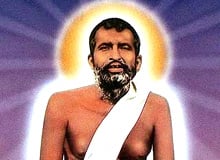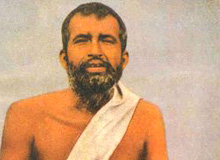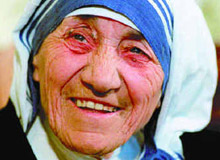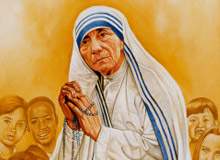Sri Ramakrishna Paramhansa
Born: February 18, 1836
Passed Away: 16, August, 1886
Contributions
 Sri
Ramakrishna Paramhansa was a popular saint of India. He had a strong
faith in the existence of god. He regarded every woman of the society,
including his wife, Sarada, as holy mother. Swami Vivekananda was one of
the prominent disciples of Ramakrishna, who later formed the
Ramakrishna Mission.
Sri
Ramakrishna Paramhansa was a popular saint of India. He had a strong
faith in the existence of god. He regarded every woman of the society,
including his wife, Sarada, as holy mother. Swami Vivekananda was one of
the prominent disciples of Ramakrishna, who later formed the
Ramakrishna Mission.
Life
The original name of Ramakrishna Paramhansa was Gadadhar Chattopadhyay. He was born into a poor and orthodox Brahmin family on 18 February, 1836 in Kamarpukur, Hooghly district of West Bengal. His parents were Khudiram Chattopadhyaya, and Chandramani Devi.
Though Gadadhar was very reluctant going to school, he had a god-gifted ability of painting and creating clay models. He was also good at learning things. He easily mastered the tales, based upon the religion. Young Gadadhar loved the nature so much that he used to spend much of his time in orchards and on the river-banks.
After the death of his father in 1843, the responsibilities of the family were handled by his elder brother Ramkumar. Ramkumar left home for Calcutta and started teaching Sanskrit in a local school. Ramkumar also served as a priest at different socio-religious functions. Young Gadadhar, back in his village started performing regular worshipping of their family-deity.
Ramkrishna at Dakshineswar
Few months later, Ramkumar was invited to Dakshineswar temple by Rani Rasmoni, the founder of the temple. Ramkumar was appointed as the chief-priest of the temple. In 1852, Ramakrishna went to Calcutta and started assisting his brother at the same temple.
In 1856, after the death of Ramkumar, Ramakrishna took his place as the chief-priest of the Kali temple. It is believed that the name Ramakrishna was given to Gadadhar by the son-in-law of Rani Rasmoni.
After being given more responsibilities, Ramkrishna began to spend much time in the "Thakur-Ghar" (home of the deity). He considered Goddess Kali as the mother of all. He wanted to see the glimpse of the god. At times, he would go into the jungle and spend the entire night worshipping goddess Kali. The activities of Ramakrishna were viewed by many as gimmick. Many believed that Ramakrishna has become "mad". With an effort to bring Ramakrishna back into the normal life, her mother began to search for a bride. In 1959, Ramakrishna was married to five year old Sarada.
 Sri
Ramakrishna was the most 'rational mystic'. With scientific precision
he put forward in most simple terms, as parables and stories, the
eternal truth regarding God and God realization. He talked about God
only after directly experiencing the reality of God. To get rid of the
thought that he belonged to a higher brahmanical caste, he began to eat
food cooked by the shudras or lower-caste.
Sri
Ramakrishna was the most 'rational mystic'. With scientific precision
he put forward in most simple terms, as parables and stories, the
eternal truth regarding God and God realization. He talked about God
only after directly experiencing the reality of God. To get rid of the
thought that he belonged to a higher brahmanical caste, he began to eat
food cooked by the shudras or lower-caste.
Sarada Devi, Ramakrishna's wife
At the age of eighteen, Sarada, the bride of the Ramakrishna, was sent to Dakshineshwar to join her husband. It was believed that the Ramakrishna regarded Sarada as the holy mother. Sarada Devi is considered as the first disciple of Ramakrishna. Even after Ramakrishna's death in 1886, Sarada Devi led the movement and worked hard to make it a success.
With Vivekananda
Ramakrishna met Vivekananda for the first time in November 1881 when Vivekananda visited Dakshineswar to know if the god really exists. In his reply Ramakrishna said, "Yes, I see God, just as I see you here, only in a much intenser sense. God can be realized,"
At first Vivekananda did not believe Ramakrishna. He felt, how such a simple man could see the God. But, gradually he started developing faith in Ramkrishna. Few days later, Vivekananda realized that Ramakrishna's words were honest and uttered from a deep experience. Vivekananda started visiting Dakshineswar frequently and a relationship of "Master and disciple" developed between the two.
At Death-Bed
In 1885 Ramakrishna suffered from throat cancer. In order to consult the best physicians of Calcutta, Ramakrishna was shifted to Shyampukur by his disciples. But with the time, his health started deteriorating and he was taken to a large house at Cossipore. His condition worsened and on 16 August, 1886, he expired at the Cossipore garden house. After the death of Ramakrishna, the monastic disciples formed a fellowship at a half-ruined house at Baranagar, headed by Vivekananda. This was the initial stage of Ramakrishna Mission.
Passed Away: 16, August, 1886
Contributions
 Sri
Ramakrishna Paramhansa was a popular saint of India. He had a strong
faith in the existence of god. He regarded every woman of the society,
including his wife, Sarada, as holy mother. Swami Vivekananda was one of
the prominent disciples of Ramakrishna, who later formed the
Ramakrishna Mission.
Sri
Ramakrishna Paramhansa was a popular saint of India. He had a strong
faith in the existence of god. He regarded every woman of the society,
including his wife, Sarada, as holy mother. Swami Vivekananda was one of
the prominent disciples of Ramakrishna, who later formed the
Ramakrishna Mission.Life
The original name of Ramakrishna Paramhansa was Gadadhar Chattopadhyay. He was born into a poor and orthodox Brahmin family on 18 February, 1836 in Kamarpukur, Hooghly district of West Bengal. His parents were Khudiram Chattopadhyaya, and Chandramani Devi.
Though Gadadhar was very reluctant going to school, he had a god-gifted ability of painting and creating clay models. He was also good at learning things. He easily mastered the tales, based upon the religion. Young Gadadhar loved the nature so much that he used to spend much of his time in orchards and on the river-banks.
After the death of his father in 1843, the responsibilities of the family were handled by his elder brother Ramkumar. Ramkumar left home for Calcutta and started teaching Sanskrit in a local school. Ramkumar also served as a priest at different socio-religious functions. Young Gadadhar, back in his village started performing regular worshipping of their family-deity.
Ramkrishna at Dakshineswar
Few months later, Ramkumar was invited to Dakshineswar temple by Rani Rasmoni, the founder of the temple. Ramkumar was appointed as the chief-priest of the temple. In 1852, Ramakrishna went to Calcutta and started assisting his brother at the same temple.
In 1856, after the death of Ramkumar, Ramakrishna took his place as the chief-priest of the Kali temple. It is believed that the name Ramakrishna was given to Gadadhar by the son-in-law of Rani Rasmoni.
After being given more responsibilities, Ramkrishna began to spend much time in the "Thakur-Ghar" (home of the deity). He considered Goddess Kali as the mother of all. He wanted to see the glimpse of the god. At times, he would go into the jungle and spend the entire night worshipping goddess Kali. The activities of Ramakrishna were viewed by many as gimmick. Many believed that Ramakrishna has become "mad". With an effort to bring Ramakrishna back into the normal life, her mother began to search for a bride. In 1959, Ramakrishna was married to five year old Sarada.
 Sri
Ramakrishna was the most 'rational mystic'. With scientific precision
he put forward in most simple terms, as parables and stories, the
eternal truth regarding God and God realization. He talked about God
only after directly experiencing the reality of God. To get rid of the
thought that he belonged to a higher brahmanical caste, he began to eat
food cooked by the shudras or lower-caste.
Sri
Ramakrishna was the most 'rational mystic'. With scientific precision
he put forward in most simple terms, as parables and stories, the
eternal truth regarding God and God realization. He talked about God
only after directly experiencing the reality of God. To get rid of the
thought that he belonged to a higher brahmanical caste, he began to eat
food cooked by the shudras or lower-caste.Sarada Devi, Ramakrishna's wife
At the age of eighteen, Sarada, the bride of the Ramakrishna, was sent to Dakshineshwar to join her husband. It was believed that the Ramakrishna regarded Sarada as the holy mother. Sarada Devi is considered as the first disciple of Ramakrishna. Even after Ramakrishna's death in 1886, Sarada Devi led the movement and worked hard to make it a success.
With Vivekananda
Ramakrishna met Vivekananda for the first time in November 1881 when Vivekananda visited Dakshineswar to know if the god really exists. In his reply Ramakrishna said, "Yes, I see God, just as I see you here, only in a much intenser sense. God can be realized,"
At first Vivekananda did not believe Ramakrishna. He felt, how such a simple man could see the God. But, gradually he started developing faith in Ramkrishna. Few days later, Vivekananda realized that Ramakrishna's words were honest and uttered from a deep experience. Vivekananda started visiting Dakshineswar frequently and a relationship of "Master and disciple" developed between the two.
At Death-Bed
In 1885 Ramakrishna suffered from throat cancer. In order to consult the best physicians of Calcutta, Ramakrishna was shifted to Shyampukur by his disciples. But with the time, his health started deteriorating and he was taken to a large house at Cossipore. His condition worsened and on 16 August, 1886, he expired at the Cossipore garden house. After the death of Ramakrishna, the monastic disciples formed a fellowship at a half-ruined house at Baranagar, headed by Vivekananda. This was the initial stage of Ramakrishna Mission.

 Mother
Teresa was a true follower of humanity. Many people considered Mother
as the "reincarnated form of Lord Jesus". Mother Teresa devoted her
entire life in serving the needy and abandoned people of the society.
Although her mission started in India, she succeeded in bringing the
people of all societies under one roof, i.e. humanity. Besides the Nobel
Peace Prize, she was also awarded with Ramon Magsaysay and Padmashri
Award for her social works.
Mother
Teresa was a true follower of humanity. Many people considered Mother
as the "reincarnated form of Lord Jesus". Mother Teresa devoted her
entire life in serving the needy and abandoned people of the society.
Although her mission started in India, she succeeded in bringing the
people of all societies under one roof, i.e. humanity. Besides the Nobel
Peace Prize, she was also awarded with Ramon Magsaysay and Padmashri
Award for her social works. The
Missionaries of Charity was formed by Mother Teresa in 1950. Today, it
consists of over 4,000 nuns. The organization, so far, has expanded its
wings to over 100 countries. The objective of the Missionaries of
Charity is to provide care and support to the sick, mentally ill, aged,
victims of incorrigible diseases, and abandoned children. The
Missionaries of Charity has opened around 20 homes in Calcutta including
a school for street children.
The
Missionaries of Charity was formed by Mother Teresa in 1950. Today, it
consists of over 4,000 nuns. The organization, so far, has expanded its
wings to over 100 countries. The objective of the Missionaries of
Charity is to provide care and support to the sick, mentally ill, aged,
victims of incorrigible diseases, and abandoned children. The
Missionaries of Charity has opened around 20 homes in Calcutta including
a school for street children.